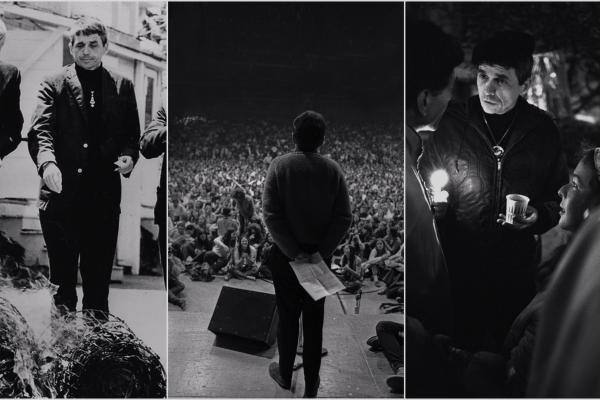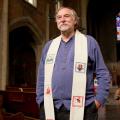On April 30, 2016, Catholic peacemaker and activist Daniel Berrigan entered life eternal. He was a teacher and friend to many in the Sojourners community. Read more reflections on Dan's life and legacy in the August 2016 issue.
I ONCE HAD a conversation with Dan about his death. We were talking late into the night at the Block Island hermitage that his friends William Stringfellow and Anthony Towne had built for him while he was two years in Danbury federal prison, a consequence of the 1968 Catonsville draft board action. He had by then foresworn scotch, on doctor’s orders, so I was being introduced to Manhattans dry, which were somehow allowed. The place suited the topic. On the wall above us was an exorcism poem that he’d hand-lettered in a style familiar to Catholic Worker and resistance houses across the country.
I’m certain it was I who broached the topic. When we met in the early ’70s, it was in the wake of notorious assassinations: Medgar Evers and Viola Liuzzo, the Panthers, Malcolm, King, the Kennedys. There was a certain youthful grandiosity in imagining that he or others who were such troublesome peacemakers would be similarly targeted. I braced my heart. I told him so. (Then he turns around and lives, thanks be, to 94!)
I probably mentioned Bonhoeffer or King and the way the blood of the martyrs is seed of movement or church, even yearning secretly myself for some sort of “meaningful death.” He gently countered with Albert Camus’ good life and the absurd car crash of Camus’ dying. So, I was as much chastened as honored when he committed the conversation to poetry:
Drinking one night, Kellermann and I
talked the moon down, ‘Think of mad racers
we’re at the mercy of
And stuttering engines of air craft
so high the guardian angels peel away—
Then street knifings. And bloody so on.
It’s certain we exist
courtesy of bellicose junkers, by merest
suffrance.’
Significant death?
Gold leaf of history, cosmetic
on a split skull.
Preparing for resistance
Our last conversation, less than a year ago, was partly about Dietrich Bonhoeffer again. The new Charles Marsh biography was out, so honest and revealing. He’d not heard tell.
It was on the 25th anniversary of Bonhoeffer’s death by hanging in the Nazi concentration camp in Flossenbürg that Berrigan went underground in 1970, refusing to submit voluntarily to unjust imprisonment. That day he began a poetic review of Eberhard Bethge’s elephantine Bonhoeffer biography just out, which was published in Saturday Review. Such publication was maddening to FBI director J. Edgar Hoover. Like other initiatives—popping up to preach in a prominent pulpit or appearing on network television and then skipping out the back door—it improvised a nation of safe houses and kept Berrigan on the Most Wanted list.
In the review, Berrigan quoted Bonhoeffer: “I am working with all my might for church resistance. But it is perfectly clear to me that this resistance is only a temporary and transitional phase that will lead on to opposition of a quite different kind. ... pray with us that it will be a ‘resistance unto death,’ and that people will be found to suffer it.”
Berrigan wrote: “To the question of whether the church should connive with the state in the suppression, deportation, and murder of the Jews, he proposed a concrete answer: the formation at Finkenwalde, in 1936, of a [community] of young seminarians, to engage in study, discipline, and prayer, and (in the event, only known afterward) to prepare for resistance and death.”
When the FBI, disguised as birdwatchers, caught up with Daniel on Block Island four months later, it was this very topic that he and William Stringfellow were discussing. Could such a seminary take form on U.S. soil in a different moment? Though they took this up again in earnest after Berrigan’s release from prison, it would be wrong to think imprisonment was an interruption of some sort. Instead, it was the immediate tryout behind bars. Pulling together a circle of draft resisters and conventional felons, Dan convened a group for study, discipline, and prayer, which eventually busted out upon the world. And only then would a group of us at Union Seminary be drawn into its next version.
While at Danbury prison, Berrigan wrote “A Letter to the Vietnamese.” A long and little-known poem, I’ve no doubt it was delivered to its intended by way of Thich Nhat Hanh, the Vietnamese Zen monk, then exiled in Paris. I once memorized it entire, and the last line still haunts my conscience: “It is snowing tonight as I vigil, the first white fall of winter. I think on the fevers and horrors of Con Son. No to their No. Yes to all else.”
A refusal to look away
Death, the great No with a capital N, riddles the culture. How does one say No and also Yes?
One way, of course, is the invention of liturgical direct action and its consequences. Ritually damaging nuclear warheads in such as the 1980 Plowshares actions or, before that, the draft board raids like Catonsville, burning the files with homemade napalm. Dorothy Day, addressing the liturgical conference, called the latter an “act of prayer,” and Stringfellow termed it “a politically informed exorcism.” A Yes in the form of a No.
But side by side with these, Dan ministered to the dying. Like Camus’ doctor in The Plague, he tended victims while saying No to the executioners. In the ’80s, he sat to the end with AIDS patients, the untouchables ravaged by both disease and culture. I got notes from him on cards depicting Christ crucified by AIDS. In Sorrow Built a Bridge, he recounted, eyes wide open with love, their crossings over.
Earlier, he had done the same at a hospice for the dying in Manhattan—specifically, poor folks with cancer. Berrigan also told their stories. We Die Before We Live (he thought the order important) collects vignettes, their ways and faces.
Dan had been led to the hospice by a young Catholic Worker serving there as an orderly. I suggest a further Worker influence. Going back to the days of Dorothy Day, the New York Catholic Worker newspaper had a practice of eulogizing guests who would ordinarily cross over in the silence of blank and nameless obscurity. Sizing up characters fit for a Dickens novel, these descriptions could be funny, heroic, quirky, but above all honest and loving. I always read them. And I know the style crept into my own approach to doing funeral liturgy.
The politics of resurrection
In the wake of Berrigan’s arrest on Block Island, Stringfellow took recourse to the book of Acts, specifically the arrest of the apostles for healing the disabled beggar and for preaching the resurrection. It was the latter which so caught his attention. He read it and read it. What could “resurrection from the dead” mean if it were cause for arrest and imprisonment? Stringfellow eventually employed this text for a sermon called “An Authority Over Death.”
The preaching of the resurrection, far from being politically innocuous, and the healing incidents, instead of being merely private, are profound, even cosmic, political acts. ... I do not imply that Berrigan is engaged in some self-conscious imitation of Peter or John or any other of the earlier Christians; I simply mean that to proclaim the resurrection in word and act is an affront which the State cannot tolerate because the resurrection exposes the subservience of the State to death as the moral purpose of the society.
Indeed. Daniel Berrigan enjoyed and exercised that freedom.
The night of our conversation about death, there was not yet a plaque of Dan’s design on the wall behind us, but there soon would be. In spring 1986, we moved Anthony’s ashes and joined them with Bill’s beside the stone wall of the cottage. The plaque was a testimony terse: “Near this house the remains of William Stringfellow and Anthony Towne await the resurrection, Alleluia.”
Now Dan’s remains in earth, like his remains in us, anticipate that same freedom.

Got something to say about what you're reading? We value your feedback!

